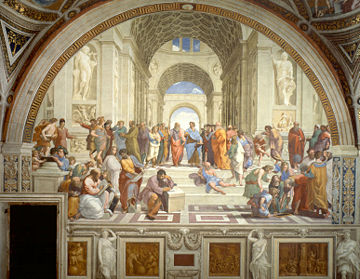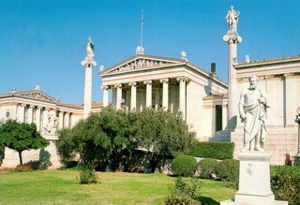Platonic Academy
- For other uses, see Platonic Academy (disambiguation).

An academy is an institution of higher learning, research or honorary membership. The name traces back to Plato's school of philosophy, founded approximately 385 B.C.E. in Akademeia, then a northern suburb of Athens.
The original Academy
Before the Akademeia was a school, and even before Cimon enclosed its precincts with a wall (Plutarch Life of Cimon xiii:7), it contained a sacred grove of olive trees outside the city walls of ancient Athens (Thucydides ii:34). The archaic name for the site was Hekademeia, which by classical times evolved into Akademeia and was explained, at least as early as the beginning of the 6th century B.C.E., by linking it to an Athenian hero, a legendary "Akademos".
The site of the Academy was sacred to Athena and other immortals; it had sheltered religious cult since the Bronze Age, a cult that was perhaps associated with the hero-gods the Dioscuri (Castor and Polydeukes), for the hero Akademos associated with the site was credited with revealing to the Divine Twins where Theseus had hidden Helen. Out of respect for its association with the Dioskouri, the Spartans would not ravage these original "groves of Academe" when they invaded Attica (Plutarch, Life of Theseus xxxii), a piety not shared by the Roman Sulla, who axed the sacred olive trees in 86 B.C.E. to build siege engines.
Among the religious observations that took place at the Akademeia was a torchlit night race from altars within the city to the Promemeikos altar in the Akademeia. Funeral games also took place in the area as well as a Dionysiac procession from Athens to the Hekademeia and then back to the polis (Paus. i 29.2, 30.2; Plut. Vit. Sol. i 7). The road to Akademeia was lined with the gravestones of Athenians.
The Platonic Academy is usually contrasted with Aristotle's own creation, the Lyceum.
Famous philosophers entrusted with running the Academy include Arcesilaus, Speusippus, Xenocrates and Proclus.
The revived Neoplatonic Academy of Late Antiquity
After a lapse during the early Roman occupation, the Academy was refounded (Cameron 1965) as a new institution of some outstanding Platonists of late antiquity who called themselves "successors" (diadochoi, but of Plato) and presented themselves as an uninterrupted tradition reaching back to Plato. However, there cannot have actually been any geographical, institutional, economic or personal continuity with the original Academy in the new organizational entity (Bechtle).
The last "Greek" philosophers of the revived Academy in the 6th century were drawn from various parts of the Hellenistic cultural world and suggest the broad syncretism of the common culture (see koine): Five of the seven Academy philosophers mentioned by Agathias were Syriac in their cultural origin: Hermias and Diogenes (both from Phoenicia), Isidorus of Gaza, Damascius of Syria, Iamblichus of Coele-Syria and perhaps even Simplicius of Cilicia himself (Thiele).
The emperor Justinian closed the school in AD 529, a date that is often cited as the end of Antiquity. According to the sole witness, the historian Agathias, its remaining members looked for protection under the rule of Sassanid king Khosrau I in his capital at Ctesiphon, carrying with them precious scrolls of literature and philosophy, and to a lesser degree of science. After a peace treaty between the Persian and the Byzantine empire in 532 guaranteed their personal security (an early document in the history of freedom of religion), some members found sanctuary in the pagan stronghold of Harran, near Edessa. One of the last leading figures of this group was Simplicius, a pupil of Damascius, the last head of the Athenian school. The students of the Academy-in-exile, an authentic and important Neoplatonic school surviving at least until the 10th century, contributed to the Islamic preservation of Greek science and medicine, when Islamic forces took the area in the 7th century (Thiele). One of the earliest academies established in the east was the 7th century Academy of Gundishapur in Sassanid Persia.
Raphael painted a famous fresco depicting "The School of Athens" in the 16th century.
The site of the Academy was rediscovered in the 20th century; considerable excavation has been accomplished and visiting the site is free. It is located in modern Akadimia Platonos. The Church of St. Triton on Kolokynthou Street, Athens, occupies the southern corner of the Academy, confirmed in 1966 by the discovery of a boundary stone dated to 500 B.C.E.
Modern use of the term academy
Due to the tradition of intellectual brilliance associated with this institution, many groups have chosen to use the word "Academy" in their name.
During the Florentine Renaissance, Cosimo de' Medici took a personal interest in the new Platonic Academy that he determined to re-establish in 1439, centered on the marvellous promise shown by Marsilio Ficino, scarcely more than a lad. Cosimo had been inspired by the arrival at the otherwise ineffective Council of Florence of Gemistos Plethon, who seemed like a Plato reborn to the Florentine intellectuals. In 1462 Cosimo gave Ficino a villa at Careggi for the Academy's use, situated where Cosimo could descry it from his own villa. The Renaissance drew potent intellectual and spiritual strength from the academy at Careggi. During the course of the following century many Italian cities established an Academy, of which the oldest survivor is the Accademia dei Lincei of Rome, which became a national academy for a reunited Italy. Other national academies include the Académie Française; the Royal Academy of the United Kingdom; the International Academy of Science; the United States Military Academy at West Point, New York; the United States Naval Academy; United States Air Force Academy; and the Australian Defence Force Academy. In emulation of the military academies, police in the United States are trained in police academies. The Academy of Motion Picture Arts and Sciences presents the annual Academy awards.
A fundamental feature of academic discipline in those academies that were training-schools for artists was regular practice in making accurate drawings from antiquities, or from casts of antiquities, on the one hand, and on the other, in deriving inspiration from the other fount, the human form. Students assembled in sessions drawing the draped and undraped human form, and such drawings, which survive in the tens of thousands from the 17th through the 19th century, are termed académies.
In the early 19th century "academy" took the connotations that "gymnasium" was acquiring in German-speaking lands, of school that was less advanced than a college (for which it might prepare students) but considerably more than elementary. An early example are the two academies founded at Andover and Phillips Exeter Academy. Amherst Academy expanded with time to form Amherst College.
Mozart organized public subscription performances of his music in Vienna in the 1780s and 1790s, he called the concerts "academies." This usage in musical terms survives in the concert orchestra Academy of St Martin in the Fields and in the Brixton Academy, a concert hall in Brixton, South London.
Academies proliferated in the 20th century until even a three-week series of lectures and discussions would be termed an "academy." In addition, the generic term "the academy" is sometimes used to refer to all of academia, which is sometimes considered a global successor to the Academy of Athens.
Honorary Academy
See the Académie Française and its many emulators among national honorary academies of strictly limited membership.
Research Academy
In Imperial Russia and Soviet Union the term "academy", or Academy of Sciences was reserved to denote a state research establishment, see Russian Academy of Sciences. The latter one still exists in Russia, although other types of academies (study and honorary) appeared as well.
United Kingdom school type
As a British school type, privately funded Academies first became popular in the seventeenth and early eighteenth centuries. At this time the offer of a place at an English public school and university generally required conformity to the Church of England; the Academies or Dissenting Academies provided an alternative for those with different religious views, called nonconformists.
University College London (UCL) was founded in the early nineteenth century as the first publicly funded English university to admit anyone regardless of religious adherence; and the Test and Corporation Acts that had imposed a wide range of restrictions on citizens who were not in conformity to the Church of England, were also abolished at about that date.
Recently Academies have been reintroduced. Today they are a type of secondary school - they no longer teach up to university degree level - and unlike their predecessors are only partly privately sponsored and independent, being partly paid for and controlled by the state. They have been introduced in the early years of the 21st century and though mainly state funded have a significant measure of administrative autonomy. Some of the early ones were briefly known as "City Academies".
ReferencesISBN links support NWE through referral fees
- Alan Cameron, "The last days of the Academy at Athens," in Proceedings of the Cambridge Philological Society vol 195 (n.s. 15), 1969, pp 7-29.
- Gerald Bechtle, Bryn Mawr Classical Review of Rainer Thiel, Simplikios und das Ende der neuplatonischen Schule in Athen. Stuttgart, 1999 (in English).
- John Glucker, Antiochus and the Late Academy, Göttingen 1978.
- Francis Haskell and Nicholas Penny, 1981. Taste and the Antique: The Lure of Classical Sculpture, 1500-1900 (New Haven: Yale University Press)
External links
Plato's Academy
- The Academy, from the Internet Encylopedia of Philosophy
- Map of ancient Athens with location of the Academy
- Plato's Academy, from the Hellenic Ministry of Culture
- Christopher Planeaux' history of the site of the Academy
- Site of the Academy rediscovered (needs better site linked)
Modern institutions
- Academy of Athens, official website of the modern institution
- Film Academy
- Academy Drama School website
- The Academy at Charlemont
- Ardennes Outdoor Academy, reminiscent of Plato's Academy, at the Thierry Graduate School of Leadership
- The Jewish Academy
See also
- National academy
- List of honorary societies
- Academician
- Military academy
ca:Acadèmia cs:Akademie da:Akademi de:Akademie et:Akadeemia es:Academia eo:Akademio fa:فرهنگستان fr:Académie ia:Academia it:Accademia he:אקדמיה ka:აკადემია lad:Akademia nl:Academie ja:アカデメイア no:Akademi pl:Akademia (starożytność) pt:Academia ro:Academie ru:Академия sq:Akademia sr:Академија fi:Akatemia
Credits
New World Encyclopedia writers and editors rewrote and completed the Wikipedia article in accordance with New World Encyclopedia standards. This article abides by terms of the Creative Commons CC-by-sa 3.0 License (CC-by-sa), which may be used and disseminated with proper attribution. Credit is due under the terms of this license that can reference both the New World Encyclopedia contributors and the selfless volunteer contributors of the Wikimedia Foundation. To cite this article click here for a list of acceptable citing formats.The history of earlier contributions by wikipedians is accessible to researchers here:
The history of this article since it was imported to New World Encyclopedia:
Note: Some restrictions may apply to use of individual images which are separately licensed.
